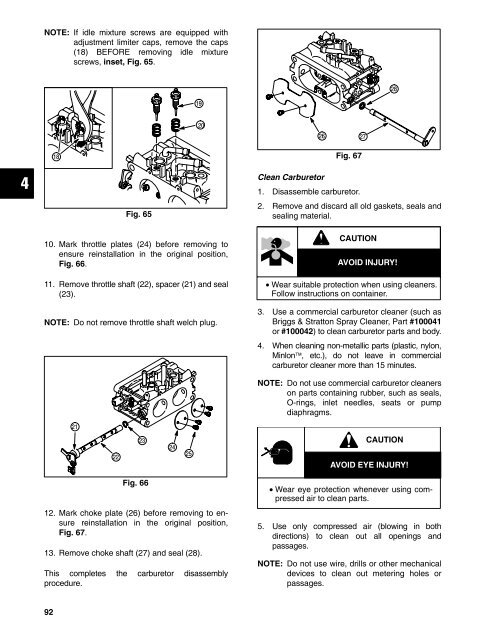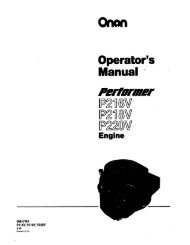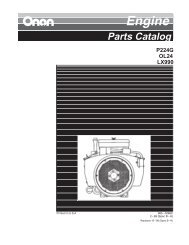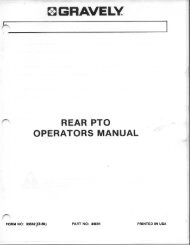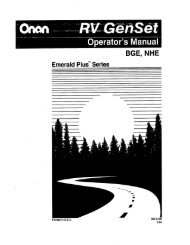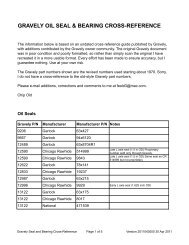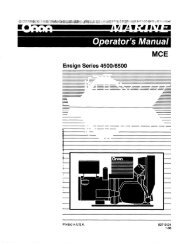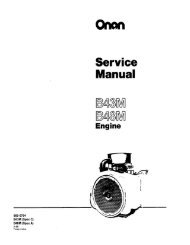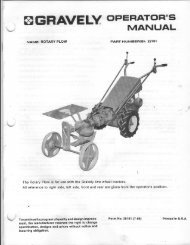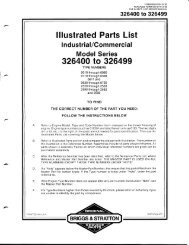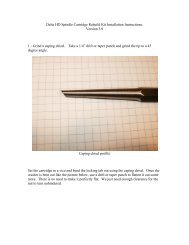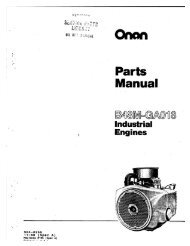272144 Vanguard Twin Cylinder OHV BRIGGS & STRATTON.pdf
272144 Vanguard Twin Cylinder OHV BRIGGS & STRATTON.pdf
272144 Vanguard Twin Cylinder OHV BRIGGS & STRATTON.pdf
You also want an ePaper? Increase the reach of your titles
YUMPU automatically turns print PDFs into web optimized ePapers that Google loves.
NOTE: If idle mixture screws are equipped with<br />
adjustment limiter caps, remove the caps<br />
(18) BEFORE removing idle mixture<br />
screws, inset, Fig. 65.<br />
<br />
<br />
<br />
<br />
<br />
<br />
Fig. 67<br />
Fig. 65<br />
10. Mark throttle plates (24) before removing to<br />
ensure reinstallation in the original position,<br />
Fig. 66.<br />
11. Remove throttle shaft (22), spacer (21) and seal<br />
(23).<br />
NOTE: Do not remove throttle shaft welch plug.<br />
Clean Carburetor<br />
1. Disassemble carburetor.<br />
2. Remove and discard all old gaskets, seals and<br />
sealing material.<br />
CAUTION<br />
AVOID INJURY!<br />
• Wear suitable protection when using cleaners.<br />
Follow instructions on container.<br />
3. Use a commercial carburetor cleaner (such as<br />
Briggs & Stratton Spray Cleaner, Part #100041<br />
or #100042) to clean carburetor parts and body.<br />
4. When cleaning non-metallic parts (plastic, nylon,<br />
Minlon, etc.), do not leave in commercial<br />
carburetor cleaner more than 15 minutes.<br />
NOTE: Do not use commercial carburetor cleaners<br />
on parts containing rubber, such as seals,<br />
O-rings, inlet needles, seats or pump<br />
diaphragms.<br />
<br />
<br />
<br />
<br />
<br />
CAUTION<br />
AVOID EYE INJURY!<br />
Fig. 66<br />
12. Mark choke plate (26) before removing to ensure<br />
reinstallation in the original position,<br />
Fig. 67.<br />
13. Remove choke shaft (27) and seal (28).<br />
This completes the carburetor disassembly<br />
procedure.<br />
• Wear eye protection whenever using compressed<br />
air to clean parts.<br />
5. Use only compressed air (blowing in both<br />
directions) to clean out all openings and<br />
passages.<br />
NOTE: Do not use wire, drills or other mechanical<br />
devices to clean out metering holes or<br />
passages.<br />
92


